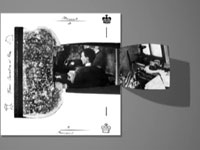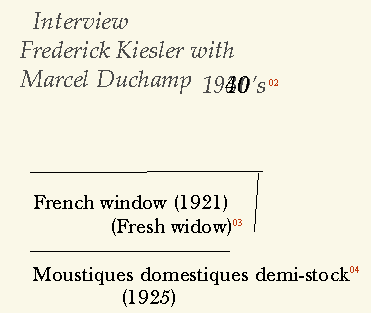click images to enlarge
- Figure 1
- Figure 2
- Figure 3
Frederick J. Kiesler and Marcel Duchamp,center fold-out tryptich for View (ed. Charles Henri Ford),vol. 5, no. 1 (March 1945), various details
Sometimes we tell each other Duchamp stories, which might surprise you since, you would reasonably point out, there is practically nothing about old Marcel that hasn’t been told, already, to death. Yet if God is in the details, the endlessly ironic touches in Duchamp´s narrative are also, even in their apparent irrelevance, the source of a strong exhilaration and brilliance.(1)~Rosalind Krauss
Frederick Kiesler and Marcel Duchamp met in the mid-1920s in Paris and stayed in contact until the early 1950s when, for reasons still unknown, their friendship suddenly seems to have fallen apart. During those 25 years, Kiesler and Duchamp worked within the same vein, both occupied with predominant themes like perception and mechanisms of visions. They shared the same friends in Paris and frequented the same intellectual circle in New York. In 1937 Kiesler published his first article on Duchamp´s Large Glass(2) based on the extensive use of photomontage and on a free association of images. Five years later, Duchamp rented a room in Kiesler´s apartment for twelve months. Also in 1942, Kiesler designed the gallery Art of This Century for Peggy Guggenheim in which he installed a Vision Machine(3) to look at a series of reproductions from Duchamp´s Bôite en Valise.(4) During the 1940s Kiesler and Duchamp collaborated on several projects such as the cover of the 1943 VVV Almanac and the exhibition Imagery of Chess at the Julien Levy Gallery in New York. In 1947 they worked together again in Paris at the Exposition Internationale du Surréalisme for which Kiesler designed the Salle des Superstitions. A few months later, Kiesler executed a portrait in eight parts of Marcel Duchamp which can probably be considered the last collaboration between the two artists.(5) The Archive of the Frederick Kiesler Center in Vienna preserves a photocopy of some handwritten notes(6) by
click to enlarge

Figure 4
Frederick J. Kiesler,
picture of Marcel Duchamp
used for View-tryptich,
1945 (Archive of the Kiesler
Center, Vienna, Austria)
Frederick Kiesler recording various events of Marcel Duchamp´s life. This copy came to our attention half a year ago. As far as we know, an excerpt from this manuscript has been quoted only by Jacques Caumont and Jennifer Gough-Cooper in their remarkable text on Marcel Duchamp and Frederick Kiesler(7) , in which they have reported a passage regarding Raymond Roussel and chess. In their text they did not specify the provenance of the source(8) but they date it to 1945, when Kiesler provided a triptych-photomontage published in View.(Figs. 1-3, 5, 6) The issue included several other texts on Marcel Duchamp, while Kiesler’s photomontage combine photos of Duchamp´s studio at 210 West 14thStreet with reproductions of his works(9) . Furthermore, the Archive of the Kiesler Center preserves some of the pictures which used to compose the triptych. (Fig. 4) Those images – in combination with the manuscript – help to complete the puzzle of the complex relationship between the two artists and they reflect Kiesler´s ability in transforming real images in surreal visions where the borderline between reality and fiction fades.
Three books inspired the decision of presenting this text in a typographical version: the Green Box by George Heard Hamilton and Richard Hamilton;Á l´Infinitif by Ecke Bonk, and last but not least Affectionately, Marcel by Francis M. Naumann and Hector Obalk. We have tried to follow this tradition in a sort of divertissement which helped us to approach the world of the »Emeritus for Chronic Diseases of the Arts«, as Kiesler once described Marcel Duchamp(10).
click images to enlarge
-

-

-
Click to see video animation (455KB)
download QuickTime Player

- Figure 5
- Figure 6
- Animation
-
Marcel
Duchamp, front cover for
View, vol. 5,
no. 1 (March 1945) -
Marcel Duchamp, back
cover for View,
vol. 5, no. 1 (March 1945) -
Frederick J. Kiesler and
Marcel Duchamp, center fold-out
tryptich for View
(ed. Charles Henri Ford),
vol. 5, no. 1 (March
1945), animated detail
Anyone who has information on the original manuscript, please contact the Kiesler Center at: research@kiesler.org
[The typeface used for Kiesler´s handwriting is Baskerville Old Face; for Lillian Kiesler´s it is Zapf Calligraphic and for the footnotes it is Times New Roman.]
Click to browse through
Notes
 1. R. Krauss, The Optical Unconscious, London/Cambridge 1996, p.95.
1. R. Krauss, The Optical Unconscious, London/Cambridge 1996, p.95.
 2. F. Kiesler, Design Correlation in: »Architectural Record« May 1937, pp.53-60.
2. F. Kiesler, Design Correlation in: »Architectural Record« May 1937, pp.53-60.
 3. For more information about Vision Machines see Y. Safran, »L´angle de l´œil« in: Frederick Kiesler. Artiste Architecte, Paris 1996 and D. Bogner »Frederick Kiesler et la Vision Machine« in: Vision Machines, Nantes 2000.
3. For more information about Vision Machines see Y. Safran, »L´angle de l´œil« in: Frederick Kiesler. Artiste Architecte, Paris 1996 and D. Bogner »Frederick Kiesler et la Vision Machine« in: Vision Machines, Nantes 2000.
 4. For more information on the gallery Art of This Century see E. Kraus; V. Sonzogni a.o., Friedrich Kiesler: Art of This Century, Ostfildern 2002.
4. For more information on the gallery Art of This Century see E. Kraus; V. Sonzogni a.o., Friedrich Kiesler: Art of This Century, Ostfildern 2002.
 5. In the 1950s no more trace of communication between them can be followed, not even through Kiesler´s wife Steffi, also a good friend of Duchamp. A reason for the end of their friendship could have been the so-called »Affaire Matta« which involved several surrealist artists following Gorky´s death in 1948.
5. In the 1950s no more trace of communication between them can be followed, not even through Kiesler´s wife Steffi, also a good friend of Duchamp. A reason for the end of their friendship could have been the so-called »Affaire Matta« which involved several surrealist artists following Gorky´s death in 1948.
 6. The manuscript is composed of five pages numbered later by Lillian Kiesler. Lillian gave it a title pertaining to the possibility that those papers could contain some notes written by Kiesler during an interview with Duchamp.
6. The manuscript is composed of five pages numbered later by Lillian Kiesler. Lillian gave it a title pertaining to the possibility that those papers could contain some notes written by Kiesler during an interview with Duchamp.
 7. J. Gough-Cooper and J. Caumont, »Kiesler und Die Braut von ihren Junggesellen nackt entlößt, sogar« in: D. Bogner a.o., Friedrich Kiesler 1890-1965, Wien 1988, pp.287-296.
7. J. Gough-Cooper and J. Caumont, »Kiesler und Die Braut von ihren Junggesellen nackt entlößt, sogar« in: D. Bogner a.o., Friedrich Kiesler 1890-1965, Wien 1988, pp.287-296.
 8. »Kiesler schrieb mehrere undatierte Seiten über das Große Glass, auf die er auch einige interessante biographische Notizen kritzelte, Informationen über Duchamp, die er zweifellos schon in der Zeit vor der Veröffentlichung inView gesammelt hatte.« (»Kiesler wrote several undated pages on the subject of the Large Glass onto which he also scribbled some interesting biographical information on Duchamp, no doubt collected prior to the publication in View«) J .Gough-Cooper and J. Caumont, ibid. p.293.
8. »Kiesler schrieb mehrere undatierte Seiten über das Große Glass, auf die er auch einige interessante biographische Notizen kritzelte, Informationen über Duchamp, die er zweifellos schon in der Zeit vor der Veröffentlichung inView gesammelt hatte.« (»Kiesler wrote several undated pages on the subject of the Large Glass onto which he also scribbled some interesting biographical information on Duchamp, no doubt collected prior to the publication in View«) J .Gough-Cooper and J. Caumont, ibid. p.293.
 9. Kiesler used a photomontage technique in combination with double exposure of the film in order to achieve, in a sort of ghostly effect, a vision of the Large Glass superimposed to a wall of Duchamp´s studio.
9. Kiesler used a photomontage technique in combination with double exposure of the film in order to achieve, in a sort of ghostly effect, a vision of the Large Glass superimposed to a wall of Duchamp´s studio.
 10. See the notes to the triptych in View (ed. Charles Henri Ford), vol. 5, no. 1, March 1945 (Marcel Duchamp number).
10. See the notes to the triptych in View (ed. Charles Henri Ford), vol. 5, no. 1, March 1945 (Marcel Duchamp number).
Figs. 1, 3, 5-6
©2003 Succession Marcel Duchamp, ARS, N.Y./ADAGP, Paris. All rights reserved.







